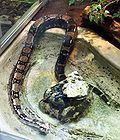Boa constrictor
Boa constrictor is a species of large, non-venomous snake found in North, Central, and South America. It is a member of the family Boidae, which includes the anacondas, pythons, and other boas. The boa constrictor is known for its distinctive pattern of brown, gray, and cream scales, and its ability to constrict its prey.
Description[edit]
The boa constrictor can reach lengths of up to 13 feet (4 meters), although most individuals are closer to 6-9 feet (2-3 meters) in length. They have a robust body, with a girth that can be as large as a human thigh. The head is distinct from the neck and has a pair of large scales, known as occipital scales, on top.
Habitat and Distribution[edit]
The boa constrictor is found in a wide range of habitats, from tropical rainforests to arid semi-desert country. However, it prefers to live in rainforest due to the humidity and temperature, natural cover from predators and vast amount of potential prey. It is also found in some cultivated areas, such as plantations and gardens.
Behavior and Diet[edit]
The boa constrictor is a solitary animal, and is primarily nocturnal. It is an excellent swimmer, but prefers to stay on dry land, living primarily in the burrows of medium-sized mammals. The boa constrictor is an ambush predator, and its diet consists mainly of small to medium-sized mammals and birds.
Reproduction[edit]
Unlike most snakes, the boa constrictor is ovoviviparous, meaning it gives birth to live young. Females give birth to litters of up to 60 young at a time, which are about 2 feet (0.6 meters) in length at birth.
Conservation Status[edit]
The boa constrictor is not currently considered to be threatened or endangered. However, habitat loss and hunting for the pet trade are potential threats to the species.
In Culture[edit]
The boa constrictor has a significant presence in human culture, particularly in literature and mythology. It is often portrayed as a symbol of strength, stealth, and lethal beauty.
Boa constrictor gallery[edit]
-
Boa constrictor, Vaňkovka, Brno
-
Boa Constrictor
-
Boa constrictor shed front
-
Königsschlange (Boa constrictor)
Ad. Transform your life with W8MD's Budget GLP-1 injections from $75


W8MD offers a medical weight loss program to lose weight in Philadelphia. Our physician-supervised medical weight loss provides:
- Weight loss injections in NYC (generic and brand names):
- Zepbound / Mounjaro, Wegovy / Ozempic, Saxenda
- Most insurances accepted or discounted self-pay rates. We will obtain insurance prior authorizations if needed.
- Generic GLP1 weight loss injections from $75 for the starting dose.
- Also offer prescription weight loss medications including Phentermine, Qsymia, Diethylpropion, Contrave etc.
NYC weight loss doctor appointmentsNYC weight loss doctor appointments
Start your NYC weight loss journey today at our NYC medical weight loss and Philadelphia medical weight loss clinics.
- Call 718-946-5500 to lose weight in NYC or for medical weight loss in Philadelphia 215-676-2334.
- Tags:NYC medical weight loss, Philadelphia lose weight Zepbound NYC, Budget GLP1 weight loss injections, Wegovy Philadelphia, Wegovy NYC, Philadelphia medical weight loss, Brookly weight loss and Wegovy NYC
|
WikiMD's Wellness Encyclopedia |
| Let Food Be Thy Medicine Medicine Thy Food - Hippocrates |
Medical Disclaimer: WikiMD is not a substitute for professional medical advice. The information on WikiMD is provided as an information resource only, may be incorrect, outdated or misleading, and is not to be used or relied on for any diagnostic or treatment purposes. Please consult your health care provider before making any healthcare decisions or for guidance about a specific medical condition. WikiMD expressly disclaims responsibility, and shall have no liability, for any damages, loss, injury, or liability whatsoever suffered as a result of your reliance on the information contained in this site. By visiting this site you agree to the foregoing terms and conditions, which may from time to time be changed or supplemented by WikiMD. If you do not agree to the foregoing terms and conditions, you should not enter or use this site. See full disclaimer.
Credits:Most images are courtesy of Wikimedia commons, and templates, categories Wikipedia, licensed under CC BY SA or similar.
Translate this page: - East Asian
中文,
日本,
한국어,
South Asian
हिन्दी,
தமிழ்,
తెలుగు,
Urdu,
ಕನ್ನಡ,
Southeast Asian
Indonesian,
Vietnamese,
Thai,
မြန်မာဘာသာ,
বাংলা
European
español,
Deutsch,
français,
Greek,
português do Brasil,
polski,
română,
русский,
Nederlands,
norsk,
svenska,
suomi,
Italian
Middle Eastern & African
عربى,
Turkish,
Persian,
Hebrew,
Afrikaans,
isiZulu,
Kiswahili,
Other
Bulgarian,
Hungarian,
Czech,
Swedish,
മലയാളം,
मराठी,
ਪੰਜਾਬੀ,
ગુજરાતી,
Portuguese,
Ukrainian




